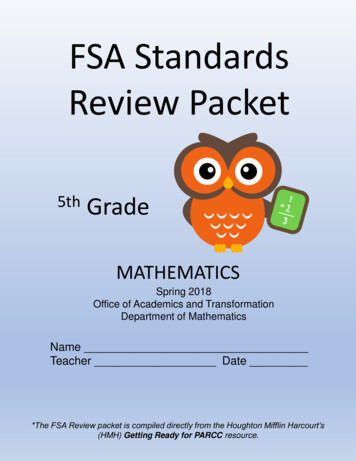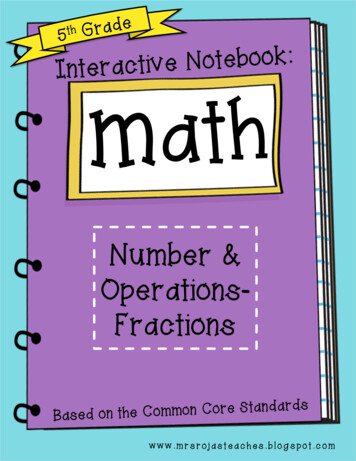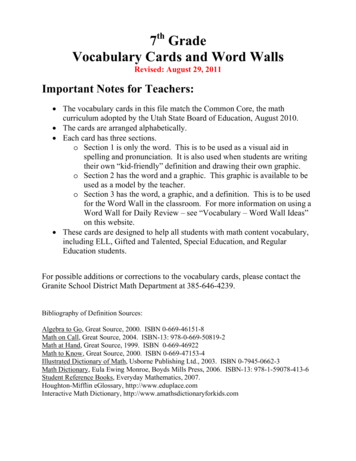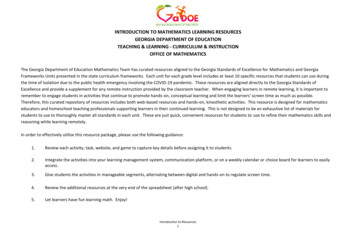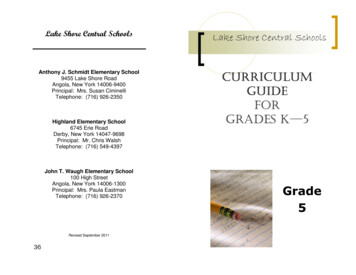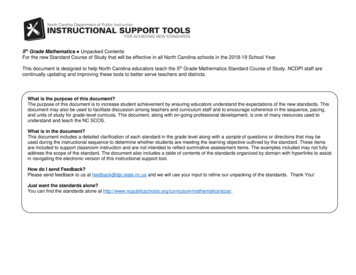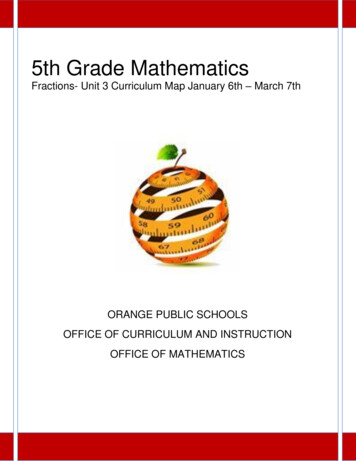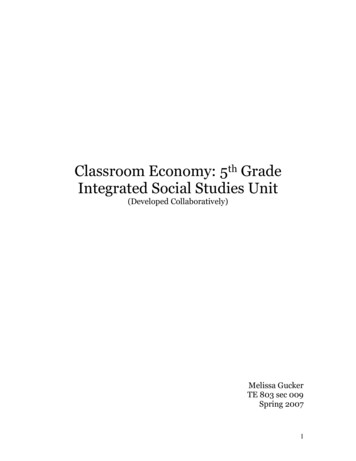
Transcription
Classroom Economy: 5th GradeIntegrated Social Studies Unit(Developed Collaboratively)Melissa GuckerTE 803 sec 009Spring 20071
Table of Contents1. Narrative Overview .32. Purposes and Goals .43. Rationale .64. List of Standards by Subject Area and Weekly Schedule Grid 85. Student Context and Features Leisa Wall‟s Context of her Classroom .13 Melissa Gucker‟s Context of her Classroom 166. Pre-Assessment Plan 197. Ten Annotated Bibliography Entries .228. Parent Letter 279. Two Completed Charts Seeing the Big Picture of your Unit .28 Assessment Plan for LACPs (lesson plans) .2910. Ten LACPs/lesson plans .3011. Unit Reflection/Evaluation Leisa Wall‟s Reflection/Evaluation .68 Melissa Gucker‟s Reflection/Evaluation .732
Narrative OverviewThrough this integrated Social Studies Unit, students are able to engage inauthentic, hands-on activities to develop and learn through problems within theirvery own classroom economy. Students are able to see how an actual economyworks from its successes to its failures. Through this unit, students are also ableto connect their present ideas to past ideas revolving around the 13 colonies andthe economies they developed that started America. Through all the successesand most importantly failures, students are able to see how conflict produceschange and how our economy was shaped to the one we see and experiencetoday.3
Purposes and GoalsBig Ideas: Conflict produces change. How does conflict bring about change?What do you want students to know? Goods include food, clothing, parts for cars, items to furnish houses, etc. Services include a person who delivers a service including nurses, teacher,fireman, police, and doctors. A producer is a person or company that makes something. A consumer is a person or company that buys or uses a product. An opportunity cost is the cost of giving up one thing to get another. Supply is how much a product or service is available. Demand is how popular the product or service is and how badly peoplewant it. Scarcity is when a product or service is not easy to get. A market economy is an economy that is regulated by the laws of supplyand demand. Conflict happens at all levels of society that produces change.What do you want students to understand? Conflict happens at all levels of society that produces change. Conflict happens in personal lives, schools, and government including inthe local, state and federal levels. The original economies that the 13 colonies set up did not survive becausethey all had a different currency. The colonies came together and formed a national economy, the freemarket economy that we know today. All economic systems are created differently and they all function based ondifferent criteria. All citizens have economic needs. The price of goods and services is set by supply and demand. When demand exceeds supply, the prices of goods will rise. When supply exceeds demand, the prices of goods will lower. We need currency to buy goods and services. A country needs to accept a currency in order for consumers to purchasespecific goods and services. Producers and consumers determine the goods and services that aparticular economy will produce.4
The role of the federal government includes carrying out functions thataffect all the people of the U.S. (collect taxes, declare wars, provides forgeneral welfare).The role of the state government includes taking action in state education,public safety, recreation, welfare, and conservation.The role of the local government includes serving counties, cities, towns,townships, villages, parks, and school districts. They also serve localpolice forces, fire departments, libraries, mass transportation, etc.What do you want the students to be able to do as a result of this learningexperience? Understand the role of the present day economy. Be able to relate the economic principals learned in this unit to real lifeexperiences not on in the present, but also the future. Be able to understand how the past affects the future and how conflictleads to certain changes within society.5
RationaleLooking through our current Social Studies curriculum, there was a lack oflessons on economics. Upon our discovery, we decided to develop theEconomics: Conflict Produces Change Unit. In our current Social Studiescurriculum, the only economic terms that students are exposed to areopportunity cost and scarcity. These are only two important economic terms. Onthe sixth grade MEAP test, students need to know terms such as supply, demand,goods, services, producer, consumer, economic needs, market economy, etc. Wefelt that we could produce an economics unit that would teach students theseimportant terms so that they would not only be successful on the MEAP test butso that they would also be successful in participating in our free market economyfor the rest of their live.We not only are going to be teaching students the necessary concepts thatthey need to know to pass the MEAP, we are also going to be teaching them abouthow a free market economy works. We are going to start off the unit talking withstudents about how conflict produces change and ask them to relate that to reallife experiences. After introducing important economic terms, we are going toallow students to work in collaborative groups and create their own economies.Students are going to see we need a common currency in order to purchase goodsand services from each other. We will then be developing a classroom economy,one that is modeled after the United States economy. Finally, we will be talkingabout supply and demand and how it affects our daily lives.6
This unit will allow students to find out with first hand experience how oureconomy was developed and how the colonists had trouble having individualeconomic systems. Students will also have a vested interest in this unit becausethey are able to create their own economies along with the goods and servicesthat their colonies will sell.There are many opportunities for inquiry during this unit. Students arecreating and investigating how our current economic system was developed.They are experiencing what our colonists experienced when each individualcolony had their own economic system; the separate colonies would not acceptthe other colonies currency. Students had to come up with a solution on how tofix the problem and this helps to promote good citizenship. Students are going tobe to working together for the common good of the classroom, just like how thecolonists had to work together for the common good of our future country. Theyneeded to develop a free marker economy and it took good citizens to create thisflourishing system.Our economics unit is extremely important for students to participate infor many reasons. The first reason is that students are going to be exposed toimportant concepts that they will see on the MEAP test and the current SocialStudies curriculum does not teach these concepts. Another reason is thatstudents will be seeing first hand how our current free market economy functionson a day to day basis. Finally, students will be developing a sense of goodcitizenship when they purchase goods and services from their peers and whenthey work together to create a classroom economy.7
List of Standards by Subject AreaSocial Studies Benchmarks SS. I.I E 1: Place major events in the early history of the United States inchronological order. SS.I.2 E 2: Use narratives and graphic data to compare the past of theirlocal community, the state of Michigan and other parts of the UnitedStates with present day life in those places. SS.I.3 E 1: Identify problems from the past that divided their localcommunity, the state of Michigan, and the United States and analyze theInterests and values of those involved SS.I.3 E 2: Select decisions made to solve past problems and evaluatethose decisions in terms of ethical considerations, the interests of thoseaffected by the decisions, and the short- and long-term consequences inthose decisions. SS.II.3 E 1: Describe major kinds of economic activity and explain thefactors influencing their location. SS.II.3 E 4: Describe some of the major movements of goods, people, jobsand information within Michigan and the United States and explain thereasons for the movements. SS.III.1 E 3: Explain responsibilities citizens have to uphold constitutionalrights. SS.III.5 E 1: Explain various ways that nations of the world interact witheach other. SS.III.5 E 2: Describe events in other countries that have affectedAmericans and, conversely, events within the United States that haveaffected other countries. SS.IV.1 E 1: Explain why people must face scarcity when making economicdecisions. SS.IV.1 E 2: Identify the opportunity costs in personal decision makingsituations. SS.IV.1 E 3: Use a decision making model to explain a personal choice. SS.IV.1 E 4: Analyze the costs, benefits, and alternatives to using consumercredit. SS.IV.2 E 1: Distinguish between natural resources, human capital, andcapital equipment in the production of a good or service. SS.IV.2 E 2: Distinguish between individual ownership, partnership, andcorporation. SS.IV.3 E 1: Use a decision making model to explain a choice involving apublic good or service.8
SS.IV.4 E 1: Explain how prices are determined in a market economy andhow they serve as a means of allocating resources.SS.IV.4 E 2: Describe how they act as a producer and a consumer.SS.IV.5 E 2: Describe benefits of international trade to consumers andproducers.SS.IV.5 E 3: Describe how businesses are involved in trade as producers,distributors, importers, and exporters.English Language Arts Benchmarks ELA.I.3 E 1: Integrate listening, speaking, viewing, reading, and writingskills for multiple purposes and in varied contexts. An example is using allthe language arts to prepare and present a unit project on a selected stateor country. ELA.I.3 E 4: Distinguish between verbal and nonverbal communication,and identify and practice elements of effective listening and speaking.Examples include recognizing the impact of variations of facial expression,posture, and volume on oral communication. ELAVII.9 E 1: Explore and reflect on universal themes and substantiveissues from oral, visual, and written texts. Examples include exploration,discovery, and formation of personal relationships. ELA.VIII.10 E 1: Identify how their own experiences influence theirunderstanding of key ideas in literature and other texts. ELA.VIII.10. E 2: Combine skills to reveal their strengthening literacy.Examples include writing and illustrating a text, reading and then orallyanalyzing a text, and listening to and then summarizing a presentation. ELA.VIII.10 E 3: Use oral, written, and visual texts to research howindividuals have had an impact on people in their community and theirnation. An example is creating texts to inform others about school orcommunity issues and problems. ELA.IX.11 E 1: Generate questions about important issues that affect themor topics about which they are curious, and use discussion to narrowquestions for research. ELA.IX.11 E 2: Identify and use the kinds of resources that are most usefuland most readily available for the particular questions or topics they wishto investigate. Examples include knowledgeable people, field trips, tablesof contents, indexes, glossaries, icons/headings, hypertext, storageaddresses, CD-ROM/laser disks, electronic mail, and library cataloguedatabases. ELA.IX.11 E 3: Organize and analyze information to draw conclusions andimplications based on their investigation of an issue or problem.Mathematics Benchmarks M.I.1 E 3: Use patterns to describe real-world phenomena. M.I.1 E 5: Apply their experiences with patterns to help solve problemsand explore new content.9
M.I.2 E 1: Recognize change and variability when it occurs in a widevariety of settings.M.I.2 E 2: Recognize that change is often predictable, but variable and thatpatterns emerge that help describe the change.M.I.2 E 3: Explore change, and realize that changes are frequentlyindependent.M.I.2 E 6: Explore variability and change in a variety of contexts,investigations and problems.M.II.1 E 4: Draw and build familiar shapes.M.II.1 E 5: Explore ways to combine, dissect, and transform shapes.M.II.3 E 1: Compare attributes of objects; develop standard units ofmeasurement; and select and use standard units of measure.M.II.3 E 2: Identify the attribute to be measured and select theappropriate unit of measurement for length, mass, area, perimeter,capacity, time, temperature, and money.M.II.3 E 6: Apply measurement to describe the real world and solveproblems.M.III.1 E 1: Collect and explore data through counting, measuring, andconducting surveys and experiments.M.III.2 E 3: Draw, explain, and justify conclusions, such as trends, basedon data.M.IV.1 E 1: Develop and understanding of whole numbers and read, write,and count using whole numbersM.IV. 1 E 4: Apply their understandings of number systems to model andsolve problems.M.V.1 E 4: Apply operations efficiently and accurately in solving problems.10
11
Weekly Schedule GridDayActivities1Conflict Produces Change Introduce Classroom Economics Unit Teacher and students create a “Conflict Produces Change” web Divide class into groups and each group will think of conflict andchange within their given topic Share as a whole groupIntroducing Economic Terms Brainstorm list of economic terms Divide class into groups of 4-5 students Each group will be responsible for some of the terms listed (canuse different resources: internet, dictionaries, books, etc ) Students then share ideas with the classIntroduce Economic Colonies Review terms from day before Introduction of development of own colonies-discussion as awhole class about what that means and how it will work Discuss centers of how the economies will be developedCenters, Creating Our Colonies Economics System Students and teacher review centers for colonies Students work in their groups to begin to develop theircolony/working economy using the centersFinal Day of Centers, Creating Our Colonies EconomicsSystem, Setting Up Our Colonies Students continue/finish working in the centers to develop theircolony/economy/productMarket Day-1st Day Students encounter the first selling day where they get to sell thegoods they have been making for the last two days Discussion of how the market day went-failure Discussion of the 1st American colonies and how it was similar towhat they experienced in their own market daySet Up a Successful Classroom Economy Meet with small groups to discuss how to improve on ourclassroom economy Class discussion on ideas that the groups came up withExperiment Using the New Classroom Economy Students will use the ideas from the previous day to completeanother market day to see how well they were able to adapt fromthe negatives Comparison of classroom economy to that of the American234567812
economic system today910Supply and Demand Student auction-students get tokens worth so much money andthey then bid on objects that the teacher provides Discussion on supply and demand based on the simulationSelf Assessment Day Students assess their performance of the whole unit using theirresponse journal rating themselves, their group, and what theythought was most important from the unit13
Leisa WallContext InformationDublin Elementary SchoolWalled Lake Consolidated SchoolsCommunity and School:Dublin Elementary is located in White Lake Township, Michigan and ispart of the Walled Lake Consolidated School District. There are 28,219 residentsthat reside in White Lake. There are 10,616 homes in the area. The Dublincommunity boasts 400 families. There are four sections at each grade levelkindergarten, first, second, third, fifth, with the exception of fourth grade, thereare only three sections. Our student body‟s ethnic background is primarilyCaucasian.Classroom:In my classroom there are 25 students. We have 16 boys and 9 girls. Theethnic backgrounds in my classroom are not diverse. We have one AfricanAmerican female and the rest of the students in my classroom are Caucasian. Allstudents in my classroom are Christians that celebrate all major holidays,including Christmas. We have one male student that is both Christian andJewish. Our African American student is also Christian but also celebratesKwanza. There are a range of ability levels in my classroom. We have twostudents who participate in REACH math which is an advanced math programthat the district has set up. We have two special needs students who receivesupport services. The rest of the ability levels in my classroom are pretty similar,14
we have some very high students and we also have some students who struggle ina few subject areas but do not qualify for special needs or services.Students:There are a few students in my classroom that have special needs. Onestudent has Attention Deficit Hyperactive Disorder (ADHD). This student has ahard time focusing on instruction and his assignments. Transitions are extremelyhard for this student; he has a hard time leaving one subject behind and movingon to anther subject. This student receives five and a half hours a week ofinstructional support from the resource room teacher. Another student in myclassroom that requires special attention is a student that has medical issues.This student had a kidney transplant this past summer so we really need to watchhim with a close eye. He is also Learning Disabled. He has an adjustedcurriculum in the areas of spelling and mathematics. He was held back when hewas in second grade and he missed most of fourth grade because of his kidneyproblems. This student is very eager to learn and to catch up to the rest of theclass. He receives ten and a half hours a week of special support from a resourceroom teacher. He does not have the same math or spelling curriculum as the restof the class and he misses out on the other subjects frequently because he has togo to the resource room. The challenge with this student is that he continues tomiss a lot of school because he is taking an experimental medication for hiskidney and he has to go in to the doctor‟s office for bi-weekly checkups.We have a student in our classroom that has a bilateral hearing loss. Hewears hearing aids in both ears to access information. He needs to sit towardsthe front of the classroom because he reads lips to help him better access15
information being presented. This child was recently tested for special needs butdid not qualify for special services or support.Social Studies Curriculum:The Social Studies in the fifth grade seems to be ever changing. At thebeginning of the school year, the entire fifth grade, across the district was pilotinga new program call sCoPe. The sCoPe program is a program unlike any thatWalled Lake Schools has tried. There is a lot of information for a teacher todecipher what is important for students to know and what can I cut out. Thereare no textbooks for students and the program contains a lot of overheads andhandouts. By December, the teachers at my school, with the endorsement of theprincipal, decided to abandon the program and go back to the old Social StudiesCurriculum. The old system involved a book for each student. Teachers had amanual that they were to follow that contained all the necessary information thatthe students needed to be taught by the end of the school year. Now we havegone back to the old way but we have decided to take a little from the new sCoPeprogram to better enhance the textbook.16
Melissa GuckerContext InformationDeerfield Elementary SchoolNovi Community SchoolsCommunity and School:Deerfield Elementary is located in Novi Michigan. Deerfield is part of theNovi Community Schools District which houses four elementary schools, one 5/6building, one middle school, and one high school. The residents of thiscommunity are predominately middle to upper class. The community has a lot ofdifferent cultures and is a community that draws in different cultures because ofhow diverse Novi schools have become. Many of the different ethnicities includeIndia, Asian, African American, and Caucasian. Deerfield Elementary hasadopted the “house system” in which the school is made up of four houses andwithin each house there is a kindergarten, two ½ classrooms, and two ¾classrooms. Students start in one house and continue their learning in the samehouse until the complete the 4th grade.Classroom:In my classroom there are 25 students. There are 12 boys and 13 girls.Along with the gender make up, there are 12 3rd graders and 13 4th graders. Theclassroom is a 3rd and 4th grade multiaged classroom. Within our classroom thereis a very diverse population. We have many different variations of Indian cultureas well as Asian. We have one African American student and the rest of ourstudents are Caucasian. The majority of our class is not Caucasian. Being in a3rd/4th grade split there are a wide array of abilities within our classroom. Wehave low 3rd graders as well as extremely high 4th graders. Although we have a17
wide array of abilities, we have no students who are labeled “special needs.” Twoof our students are being tested and evaluated for ADHD, however, nothing hascome from that thus far. We have 2 students who did receive speech help in 1stand 2nd grade, but no longer have that help nor need it.Students:As noted before, we have no students who are actually labeled “specialneeds.” However, we have two students who are being tested and evaluated forADHD. These two students have a hard time focusing and sitting for long periodsof time. They find written exercises somewhat boring and tedious. These studentsare extremely unorganized and need help when collecting assignments orprojects. These students need constant reminders and need directions to berepeated after told to the whole class. One on one instruction works best for thesetwo and having those students repeat the directions to one another also helpswhen it comes to getting the specifics for an assignment. As the teacher, it ishelpful to collect all their work and show these students how things should beorganized or kept in their desk.Social Studies Curriculum:Within Deerfield Elementary, the Social Studies Curriculum is developedaround the Scope Lessons and Units. Teachers meet with each other duringspecified times to develop units based off of the Scope Units. The teachers withinmy school decide what information is most important for students to know basedoff of the benchmarks and standards. Students have no textbooks, just referencebooks. Not every student has one of these and students do not get to keep thesebooks in their desk. During research projects students are able to use these books18
to gather information or to look deeper into a concept, but these books are rarelyused. The Scope Units have proven to be helpful and worthwhile for this year‟sSocial Studies Curriculum.19
Pre-Assessment PlanIn order to find out students prior knowledge of economics, we askedstudents to fill out a survey that asked them to provide basic information abouteconomics. 25 students were given a five question survey. Those five questionsincluded “What is economics?” “Why do we need money?” “How is moneymade?” “How does a person get money?” “Why isn‟t everything in the worldfree, why do most things cost money?” Before we passed out the surveys, weexplained to our students that this sheet of paper was for our information only.We told them that we were developing a unit on economics and we would likethem to let us know what prior knowledge they had on the topic. We made sureto inform them that there were no right or wrong answers here and that theywould not be graded. We just wanted them to let us know what they alreadyknow about economics. Students got right to work and took their answers to thequestions very seriously.The student‟s responses to the first question, “What is economics?”surprised us. Multiple students responded to that question with “the study ofmoney.” Other students responses included “Money and Business,” “Money andWealth.” “Money and the way people live,” and “A thing that helps you in yourlife.” We were extremely excited that most students knew that economics hassomething to do with money. We did not get extremely detailed answers but wewere ok with that. All that we wanted was for students to tell us what theyhonestly know about economics and we feel that they did a great job on thatquestion.20
The second question, “Why do we need money?” students responded in asimilar manner. They all know that we need money in order to pay for ourshelter, food, and clothing. Student responses included “So we can buy stuff,”“We need money to pay other people for our needs so they can produce more ofour needs,” “So we can pay taxes,” “To survive,” and “To bargain for things foryou and your family.” All students understand that we need money to buy goodsand services. We were a little surprised by the last response, “To bargain forthings for you and your family.” This statement surprised us because we do notbargain for items in America; they do that in other countries. We can tell that weare going to have to address this misconception during our unit, teachingstudents that in America, there is a price that is set by supply and demand.The third question on the survey, “How is money made?” gave us a widerange of answers. A few students said that the government makes the money andit is made in a factory in Washington D.C. Other responses included “When yougo to work for a week, at the end of the week you get a paycheck,” “By a machineprinting things on green pieces of paper,” “In a factory,” and “Trees.” Again moststudents know that the government makes the money and this fact is nice toknow because then we do not have to spend any time teaching students howmoney is made. We can include it in our unit, but we do not have to spend a lotof time talking about it.The student‟s responses to the fourth question, “How does a person getmoney?” were all the same. Students know that in order to get money, you mustwork at a job. Other students responded “They get money by going to a bank,” “Aperson gets money from working hard,” “They sell something.” The first two21
responses are accurate but they do not tell me whether the student understandshow a person makes money. We will address this when we are teaching our unit.The fifth question “Why isn‟t everything in the world free, why do mostthings cost money?” provided us with many different responses. Student‟sresponses included “If everything was free, no one would work,” “So they can payfor the government,” “Because the more money you have, the more things youcan get,” “It is not free because it costs money to make the stuff,” “People need toget paid because it is not fair to the people who make things,” “It is not freebecause businesses need money to operate,” and “Everything in the world isn‟tfree because life wouldn‟t be fair without money and we are limited on somethings and some things are illegal.” The various responses to this questionhelped us to understand that some students understand why we need money, butthe majority of my class does not understand why we need money. By askingstudents this last question, it helped us to realize that this is something that wewill need to talk about in our unit.This five question survey of our student‟s prior knowledge was extremelyworthwhile for us as we begin to plan our unit. Student‟s ideas have helped us tosee which direction we would like to take our unit, what areas we can skip over,and which areas we need to teach. This five question survey on economics wasextremely valuable and we feel that it will be worthwhile for us to keep all of thisinformation in mind when we are planning our unit.22
Annotated Bibliography1. Social Studies MEAP Sample Assessment/ MEAP VocabularyBy: Michigan Geographic Alliance, Central Michigan UniversityResource Type: TeacherThis sample test allows teachers to see what their students will be testedon. In the economics portion of the test, students are asked to read a passageabout Burger Zone, Inc. and answer follow up questions on the next page that arerelated to economic terms. This sample test is a great resource because it allowsteacher to see what their students will be tested on. The language in at a 5th/6thgrade reading level and it is not content heavy. The passage gives you thenecessary information to answer the questions. The only bias in this test is that itis written at a 5th/6th grade level and not all students read at that level. This testrelates to the unit because it allows me (the teacher) to know what terms I needto teach my students for the upcoming MEAP test.2. Understanding Economics, VideoBy: Rainbow Education MediaResource Type: StudentThis 25 minute video helps students to understand economics termsincluding resources and choice, money, and supply and demand. The video isbroken up into three different segments which fully explain each term and howstudents are affected by economics each day. The video will help enhancestudents understanding of various economic terms, the quality it exceptionallyworthwhile. This video is extremely valuable for students to watch that arelearning about economics. It takes the economic terms that students are learningabout and places them in a real world context, different situations that actuallyapply to children. There seems to be no bias in this video. Both genders areequally represented as well as many different ethnicities. This video relates to theunit because students are
the sixth grade MEAP test, students need to know terms such as supply, demand, goods, services, producer, consumer, economic needs, market economy, etc. We felt that we could produce an economics unit that would teach students these important terms so that they would not only be successful on the MEAP test but
